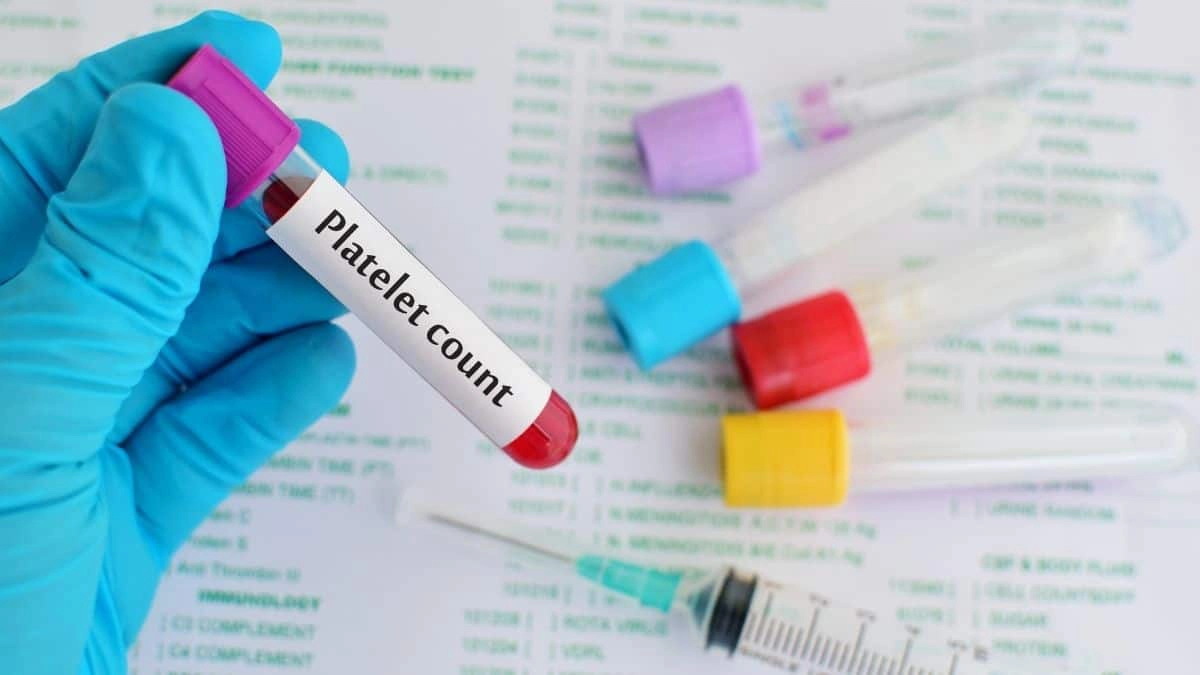What is Normal Platelet Count and How Does it Work?

Normal platelet count is a marker of the health of the body. It is a measure of how many platelets are in the blood, and it can be used to diagnose diseases and monitor patients.
Platelet count is a very important measurement measured in blood samples in hospitals.
Platelet count is a common and important measurement in hospitals. It is measured in blood samples to assess the level of blood clotting and to avoid bleeding due to, for example, surgery or certain injuries.
Blood clotting can be compromised by numerous factors, including stress, pre-existing conditions such as diabetes or kidney disease, and the use of certain medicines, and certain medications.
What is Platelet?
Platelets are the tiny cells in your blood that help your body stop bleeding. Platelet counts can be affected by various factors, such as age and medication use. This article will explore normal platelet counts at different ages and discuss some possible reasons why they might change.
Normal Platelet Count by Age
- 0-11 months: 150,000-450,000 platelets/microliter
- 12-23 months: 150,000-350,000 platelets/microliter
- 24 months to 11 years: 140,000-400,000 platelets/microliter
- 12 years and up: 150,000-450,000 platelets/microliter
Possible Causes of Low Platelet Counts in Adults
Bone marrow disorders such as aplastic anemia or Autoimmune leukemia diseases that damage the body’s blood cells Blood cancers like lymphoma and multiple myeloma Infections
Gastrointestinal bleeding Medications Certain autoimmune diseases like rheumatoid arthritis or lupus
A low platelet count may result from several conditions, including:
- Bone marrow diseases, such as leukemia or myelodysplastic syndrome (MDS)
- Diseases that suppress blood cell formation in the bone marrow, including chemotherapy treatment for cancer and autoimmune disorders like lupus
- Some immune system conditions cause frequent bleeding or bruising, such as ITP.
- Blood loss due to injury or surgery
- Certain types of cancer and their treatments;
- Bone marrow diseases like leukemia and myelodysplastic syndrome (MDS); and
- Autoimmune disorders such as ITP. An autoimmune disorder is
Signs of an abnormal or low platelet count include
- Petechial
- Bruising
- Nosebleeds
- Bleeding gums
- Heavy menstrual periods that last longer than 7 days or have a period more often than every 2 weeks.
Treatment for low blood counts
Get plenty of rest and drink lots of fluids; take iron supplements for anemia; take vitamin B12 injections if you are deficient in this nutrient; take medications prescribed by your doctor to help stimulate the production of new red blood cells (e.g., Epogen)
Possible Causes of High Platelet Counts in Adults:
Decreased platelets can be seen with bleeding disorders such as Von Willebrand disease or thrombocytopenia. However, this is not common and generally does not need to be diagnosed unless you have complications.
Anemia is another possible cause of low platelets, caused by malnutrition or the body’s inability to produce enough red blood cells (hemolysis). In some cases, low vitamin B12 and folate levels may also lead to lower platelet counts.
A variety of medications can affect your platelet count.
These include
- chemotherapy drugs,
- rheumatoid arthritis or lupus,
- and ibuprofen.
Possible causes of high platelet counts in adults are less common than low platelet counts.
- Increased platelets can be seen with leukemia
- multiple myeloma,
- and some types of liver cancer.
- Certain medications, such as birth control pills, can also cause a temporary increase in platelet counts.
- Bone marrow disorders such as aplastic anemia or leukemia
- Autoimmune diseases that damage the body’s blood cells
- Blood cancers like lymphoma and multiple myeloma
- Infections
- Gastrointestinal bleeding
- Medications
- Certain autoimmune diseases like rheumatoid arthritis or lupus
What is the platelet count, and what does it do?
The platelet count measures the number of platelets in your blood. Platelets are important for clotting and preventing excessive bleeding. A normal platelet count ranges from 150,000 to 450,000 per microliter of blood.
The normal platelet count changes as you age. Babies and young children have a higher platelet count than adults. The average platelet count for newborns is 350,000 to 400,000 per microliter of blood. Platelet counts decline gradually with age and reach the adult level at about 20.
What are Platelets, and what is the Role of Platelets in the Body?
- Platelets are small blood cells that help to keep our blood vessels open. They also help to regulate the clotting process and prevent bleeding.
- A new study has found that a blood test designed to detect clots in the arteries of patients could also be used to detect bleeding in the brain.
- Platelets are the most abundant cells in the body. They come from diverse sources, such as blood stem cells (the white blood cells) and bone marrow-derived myeloid progenitor cells (the hematopoietic stem cell).
- All cells need to renew themselves every several months. Platelets are the most abundant cells in our body, and hence we can say that they are the main source of blood cells. There are multiple platelet types, but they all share the same basic structures: a platelet membrane with a large surface area.
- Platelets are the first line of defense against injury during blood coagulation, and they play a vital role in regulating blood clotting. This article will explore working with platelets in your next dream project.
What is the importance of Platelet Count in medicine?
Normal platelet count is a very important parameter in the field of medicine. It is a very important parameter because it can be used to diagnose diseases, and it can also be used to treat diseases.
While many diseases have no treatments available and the cure is unknown, other diseases can be treated. For example, if we take diabetes, it can be treated with medicines and medical devices like insulin pumps. However, there is no cure available for many other diseases like cancer or multiple sclerosis, and treatments need to be found.
This is a world where everything is possible and within reach. The new generation technology of diagnostics and treatment makes the world a better place for all of us.
What is a Safe Platelet Count?
Safe platelet count is a vital blood cell that helps form red blood cells. It is also called erythrocytes. The platelets are responsible for the clotting of blood and thus can be used to treat bleeding disorders. The platelets are also responsible for removing dead cells from the body and thus can be used to treat cancer patients.
The platelets are one of the main components in blood that help remove dead cells from the body; they can be used to treat cancer patients and can also be used to prevent this disease from spreading.
How to Calculate Normal Blood Pressure in Adults?
Normal blood pressure is one of the most important indicators of health. It is used as an indicator of disease and to monitor the progress of an illness. It is used as an indicator of disease and to monitor the progress of an illness. However, it is not easy to detect high blood pressure.
Humans have had high blood pressure since they lived thousands of years ago. The average person has 300-500mmHg of blood pressure. However, many people have hypertension (high blood pressure), and it is hard to detect this condition in the morning if not detected in the evening.
People with high blood pressure are at higher risk of developing heart disease and stroke. They can affect our whole life by increasing the chance of having a heart attack or stroke. It is recommended that people with high blood pressure be treated as soon as possible after it is detected.
What is Healthy Blood Pressure? What is Safe Blood Pressure in Adults?
Blood pressure is a vital part of our body. It helps us regulate the amount of blood in our body, and it is also responsible for controlling the heart rate, keeping us alive and healthy.
The normal blood pressure range varies from person to person. Some people have a higher blood pressure than others, and others have a lower blood pressure than others.
This is a very interesting topic, and it is useful in various ways. We can learn something about the human body and be aware of the normal blood pressure levels in different people.
Normal Platelet Count (CR) important in body defense
Normal Platelet Count (CR) is vital because it is a good measure of the blood’s ability to help fight infection (plague, cold, etc.). The normal range represents the number of red blood cells per milliliter of blood. A doctor can check this twice a week or an imaging test such as an ultrasound or MRI. It is also used for epidemiological studies and research into chronic diseases. However, when not taken daily, you could suffer from anemia. An important feature of this test is that it does not use invasive techniques like taking out your heart or lungs and connecting them to machines that measure your blood flow which requires special expertise and a health insurance policy. Also, being watchful for abnormal values allows different healthcare professionals to establish an underlying cause for your symptoms.
Should you take your children’s or grandchildren’s blood results?
If you want to use your blood results as evidence in court, you need to know when it’s okay. This information might also come in handy if you ever get sued.
It’s important to be clear and precise when communicating with health insurance companies. The meaning of a blood test could be easily misunderstood. But, you don’t have to worry if you ever get sued because you can get that information from the court dockets.
How to Perform the Normal Platelet Test
Platelet tests diagnose various diseases, such as heart disease, cancer, and others. However, these tests are not always accurate. Even though the test is very simple to perform, it can be difficult for a lazy person. Therefore, doctors and other health care professionals need to have access to accurate information about the test.
The medical community is constantly facing conflicting information. It is important to have access to accurate information about the test that a doctor is offering in today’s world. The time required to research and evaluate various tests needs to be minimized.
The time required to research and evaluate various tests needs to be minimized. Automating this process can save a great deal of time and money.
How is AGE Determining the Blood Levels of Human Eggs & Blood Cells?
The level of blood cells in the egg is determined by the age at which it is fertilized. The human body changes with age, which can be seen in blood levels of eggs, platelets, and white cells. This change can affect your health.
The egg is the starting point for all life. From the egg, a single cell of an adult develops into a complete organism. It grows, changes, and reproduces. These happenings are crucial to the development of all living beings on earth.
How do I respond to hereditary blood disorder?
This is a question that is asked daily. One of the common myths is that “HBD” (a hereditary blood disorder) does not exist and can be automatically controlled. However, there are three types of hereditary disorders:
- Single-gene disorders, where a mutation affects one gene. Sickle cell anemia is an example.
- Chromosomal disorders, where chromosomes (or parts of chromosomes) are missing or changed. …
- Complex disorders, where there are mutations in two or more genes.
People with hereditary disorders are born with a specific genetic mutation. These mutations cause certain diseases, and the disease persists in the family line. These mutations are prevalent in the family line and can cause various diseases and disabilities in certain families.
Conclusion
Normal platelet count is an important test for many reasons. It can help determine whether people are at risk of developing different kinds of diseases or healthy. In addition, it can be used to predict how long someone will live or how well they will do after a certain disease has taken effect on them. For example, suppose someone has had their platelet count fall below normal levels recently. In that case, they may have been diagnosed with cancer or heart failure and need treatment sooner than someone who hasn’t had their platelet count fall below normal levels recently.




